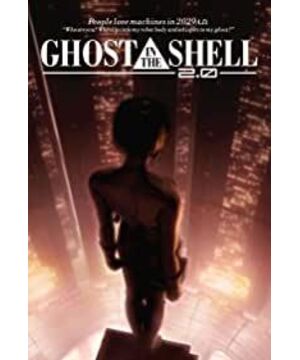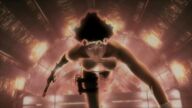1. For the title part, it is better to use 3D in the remake (after all, the original version has been learned by Matrix); but for a dive, obviously because the blisters cannot be perfectly circular , so the original hand-painted is better.
The remake has removed some overly obvious symbols and hints. This is a matter of opinion. Personally, it is more welcome. The "quasi first-person perspective conversion" is used extensively here, not only the original setting is used (the original work rarely uses this technique), but the implication is very obvious. The mirror, the water surface, the eyes of others, etc. all imply the role/personality toggles and blurs. But I personally think that these are actually good-looking, and it would be better to reduce them further.
In the end, the puppet turned the voice of a big man into a female voice with the same appearance (and it was Ryoko Kanbara!), which was a big welcome in terms of eye-catching (of course, it is also a symbol of mirror fusion in order to weaken the original symbol of male and female reproduction) .
2 One of the great advantages of this film is that the creators of the original work and animation are weapon lovers, so they spend a lot of details to describe the preparations, tactics, and psychological confrontation. Compared with the frequent mistakes and omissions in many TVs, it can be said that I don't know where the genius is.
3 The original work is too early, so some details do not seem realistic now, such as public telephones. In addition, the doctor obviously uses the C program for analysis, but personally thinks that it is more reasonable to use a scripting language at this time - of course, it is not ruled out that the scripting language that looks very similar to C is used.
The monitoring screen of the policeman is also not customary. Even for the character interface, most of them will use a multi-color + alignment table, as long as you have seen the soft monitoring interface in various enterprises, you will know.
Of course, it is also possible that someone habitually uses the Unix default habit of randomly outputting all stdout. In fact, there are many people who do it because they are lazy. At least I also output casually in the unimportant program monitoring part. (But the real log file will pay attention to the output, because it is for other programs to analyze, and it can't be analyzed if it is messed up a bit.)
4 The part about intelligence, personality and memory in it, most people seem to be very deep, but If you have a programming background, it is not difficult to understand.
A personality requirement is self-knowledge (+ some other stuff). A computer is a metaphor for human beings, with hardware and software. Hardware in turn includes thinking, feeling, and action. Software in turn includes programs and data.
Because in the past humans were the only self-aware intelligent objects, many people tended to associate personality with specific hardware (especially sensory organ) data (memory) and ignore other parts. As a computer designer, it is possible that hardware is more concerned with thinking than feeling, and software is more concerned with programs and algorithms than data such as memory, because the latter can be easily replaced, while the former is more difficult to manufacture and improve. [Rational consideration]
But for human sensibility, feeling and memory are the most important basis for us to realize that we are ourselves. Human hardware determines that human sensory organs cannot confirm their own thinking organs (eyes cannot see their own brains), and human memory cannot confirm human thinking patterns (because human computing programs themselves are part of human data, and vice versa The same is true, on the contrary, it is easy for computers to distinguish between the two.) [Perceptual considerations]
If we only focus on the separation of hardware and software, the discussion and understanding of the problem will be too simple, and most of the discussion in it will be lost. Oshii's performance of the problem was too focused on one part, but he did not lose the description of the whole problem, so although there was some dissatisfaction, it was still acceptable.
5 The ending part rises from "Why I am me" to "the meaning of my existence (as a part of life)", if it is the somewhat gloomy (and not open-minded) Moko in the animation, it is too straightforward and Calm down. But if it is the hedonistic and adventurous man in the original comics, who has a plan for everything, and has both realism and personal ideals (relative to the social ideals of monkeys), it would be very reasonable.
From the perspective of the entire life system and race, the question of whether an individual exists or not can be considered objectively.
View more about Ghost in the Shell 2.0 reviews











